Weather Almanac for March 2006
WEATHER AND TRAINS

It was snowing and I was determined to go no where this day. I have a great desire to stay put when weather turns nasty. And with snow or freezing rain, that feeling is amplified. Part of the reason is that I always want to look at the weather and not the road or traffic. Call me a wimp, but having had a car accident in an ice storm and spent 8 hours on the road in a snowstorm trying to make a one-hour trip, I have my experiences that tell me to stay close to home. Not that I hide away during bad weather, it is just that I let my feet be the mode of transportation during excursions at these times. I love to walk in a snowstorm and see the magic of winter weather first hand, even if it freezes my nose and messes my glasses.
We know how weather can disrupt transportation — just watch the tv news when winter and spring storms rush across the continent. As winter flows along, those trying to drive cars and trucks on snowy or icy roads know full well the hazards of weather. And storms in any season can play havoc with air travel, often making a mess of holiday travels. Devastating weather impacts on ships — the Edmund Fitzgerald, the Princess Sophia, and the Venture to name but a few — have gone down in legend and memory.
The final major means of transportation has always been my favourite: railroading. I grew up outside Chicago, the rail hub of America in the last days when steam dominated railroading. I remember the lonely wail of the whistles as trains rumbled across the Illinois countryside late at night, and they always sounded more emotional when interspersed between rips and rumbles of thunder. However, I then thought that weather had limited impacts on train travel unless tracks were washed out by flood or mountain passes closed by snow. But it turns out I was mistaken in my belief in the power of the locomotive.
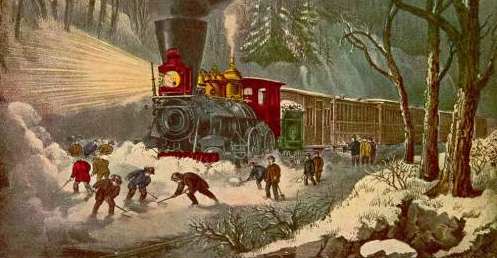 American Railroad Scene. Snow Bound
by Currier & Ives, 1871
March marks the anniversary of the greatest weather-related rail disasters in Canada and the United States. Both resulted from avalanches. But in doing my research I was surprised to see that moving trains have been hit by tornadoes, and not just once or twice in North American history. An extensive list of these encounters is given in the Tornadoes and Trains article associated with this piece. Of course, even straight-line winds can blow a train from the tracks as I reported in my piece on Newfoundland's Wreckhouse winds.
Temperature extremes can play havoc with rails, causing them to separate and buckle through contraction and expansion of the metal, such movements can cause derailments. Fog was the culprit on 4 December 1957 in St. John's, England when one commuter train crashed into another leaving 92 dead and 187 injured. Flash flooding has also caused railroad accidents, particularly when they undermine or wash out bridges and trestles. Among the most deadly of these in the United States occurred on 7 August 1904 near Eden, Colorado when a train derailed during a flash flood and killed 96 aboard.
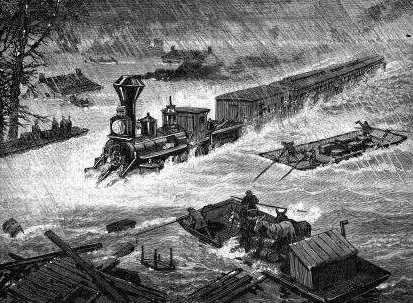 Louisiana: the Heavy Floods in the South
-
Scene on the Jackson Railroad near North Pass
from Frank Leslie's Illustrated Newspaper, New York, February 26, 1881
Snow and Trains
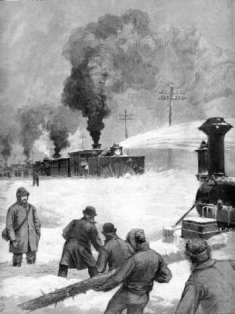 Snow and ice always worried early railroaders, particularly in the mountains of the American West. It perhaps is not surprising that the first snow plows to be used with railroads were developed in North America. Snow and ice always worried early railroaders, particularly in the mountains of the American West. It perhaps is not surprising that the first snow plows to be used with railroads were developed in North America.
The building of the North American transcontinental railroads was greatly hampered by heavy snows in the mountains from the Rockies to the Pacific Coast. In Canada, the mountains of British Columbia, the Rockies and western chains, proved daunting to the builders and operators of the transcontinental railroad. Similar problems arose in the United States, particularly in the construction of the first transcontinental link as it moved through the Sierra Nevada Mountains. There, very heavy, wet snows are common and depths often reach daunting accumulations.
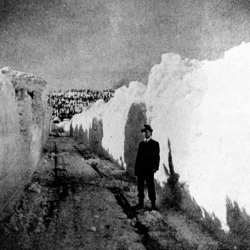 | Cleared train tracks in the Sierra Nevada
at Blue Canyon, California, after 1917 snowstorm.
Courtesy of the Historic National Weather Service Collection,
originally published in
Monthly Weather Review October 1919 |
Particularly bad for the construction of the Central Pacific line was the Winter 1866-1867, which brought forty-four separate storms and more than 40 feet (12.2 m) of snow fell, surpassing the record wet winter of the previous year in central California. The snow pack averaged eighteen feet (5.5 m) at the summit and filled many of the canyons and cuts through which the track was to move. The Chinese labourers were forced to dig snow tunnels 50 to 500 feet (15 to 150m) long just to reach the rock surfaces they were to tunnel through. The blasting of the rock often caused huge avalanches to roll down the mountains, burying workers alive.
The heaviest storm rolled in on 18 February 1867 and continued until 22 February. In its wake, powerful winds continued the blizzard conditions as the powder swirled in the air. On the heels of this storm, a second arose on 27 February and blew unabated until 2 March. Total snowfall was estimated at six feet (1.8 m) from the first storm and four feet (1.2 m) from the second. Huge drifts deposited by the storm winds clogged entrances to every tunnel being cut. On the eastern approach to the Summit Tunnel, workers were forced to extend their snow tunnel fifty feet (fifteen metres) in order to reach their camp. It is known that twenty Chinese labourers died in one avalanche, but the total number lost during the winter will never be known.
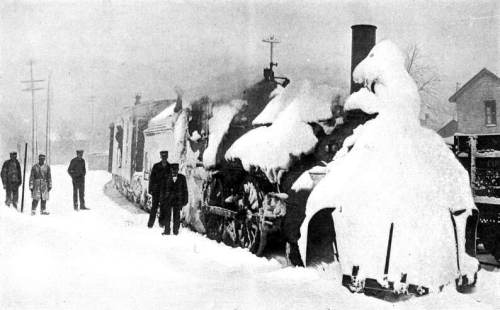
During heavy snowfalls it has been almost impossible for the railroads
to maintain their schedules as illustrated by the appearance
of this train has just arrived at Cedar Falls, Iowa.
Photograph from February 26, 1910 issue of Harpers Weekly
Completion of tracks was only the first battle of the transcontinental railroads with winter weather. Once trains began running, the fight became to keep the tracks open during the succeeding winters. The railroads build snowsheds to protect the more vulnerable sections of rail and in some cases, were forced to tunnel through the hard mountain sides to bypass particular section of right of way. The need for two of the longest North American tunnels became imperative within days of each other in the snowy Winter of 1910 in the Pacific Northwest when tragedy showed the vulnerability of sections of track to avalanches.
Learn More From These Relevant Books
Chosen by The Weather Doctor
Written by
Keith C. Heidorn, PhD, THE WEATHER DOCTOR,
March 1, 2006
The Weather Doctor's Weather Almanac Weather and Trains
©2006, Keith C. Heidorn, PhD. All Rights Reserved.
Correspondence may be sent via email to: see@islandnet.com.
For More Weather Doctor articles, go to our Site Map.

I have recently added many of my lifetime collection of photographs and art works to an on-line shop where you can purchase notecards, posters, and greeting cards, etc. of my best images.

Home |
Welcome |
What's New |
Site Map |
Glossary |
Weather Doctor Amazon Store |
Book Store |
Accolades |
Email Us
|



|











